资讯
-
 【创源大讲堂】Generator polynomials of cyclic expurgated or extended Goppa codes数学学院2024年1月18日上午10:00西南交通大学犀浦校区7510岳勤内容简介
【创源大讲堂】Generator polynomials of cyclic expurgated or extended Goppa codes数学学院2024年1月18日上午10:00西南交通大学犀浦校区7510岳勤内容简介 -
 【创源大讲堂】New product formulas for classical Gauss sums数学学院2024年1月18日上午9:00西南交通大学犀浦校区7510张文鹏内容简介
【创源大讲堂】New product formulas for classical Gauss sums数学学院2024年1月18日上午9:00西南交通大学犀浦校区7510张文鹏内容简介 -
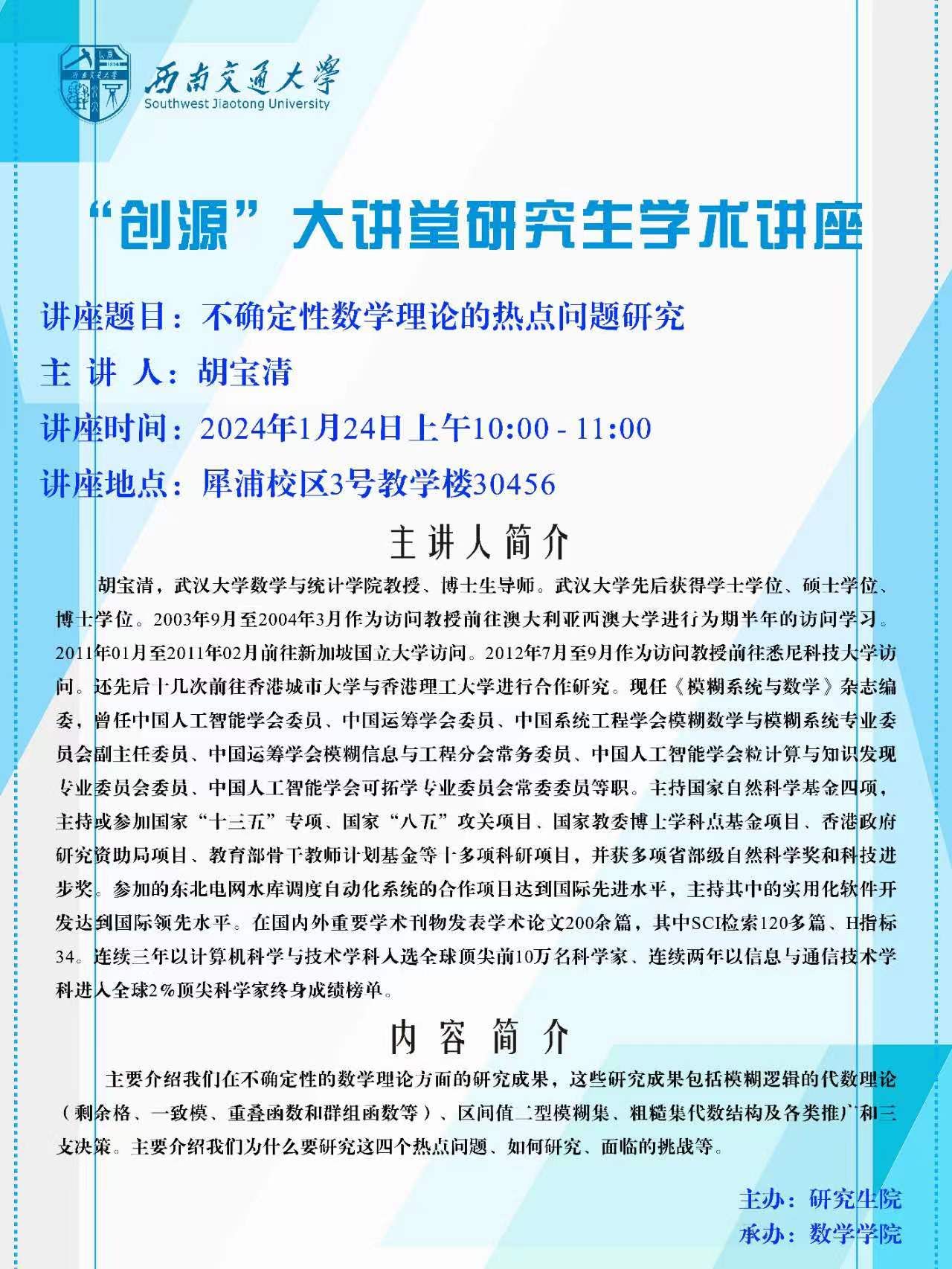 不确定性数学理论的热点问题研究数学学院内容简介
不确定性数学理论的热点问题研究数学学院内容简介 -
 Fuzzy sets as enriched categories数学学院内容简介
Fuzzy sets as enriched categories数学学院内容简介 -
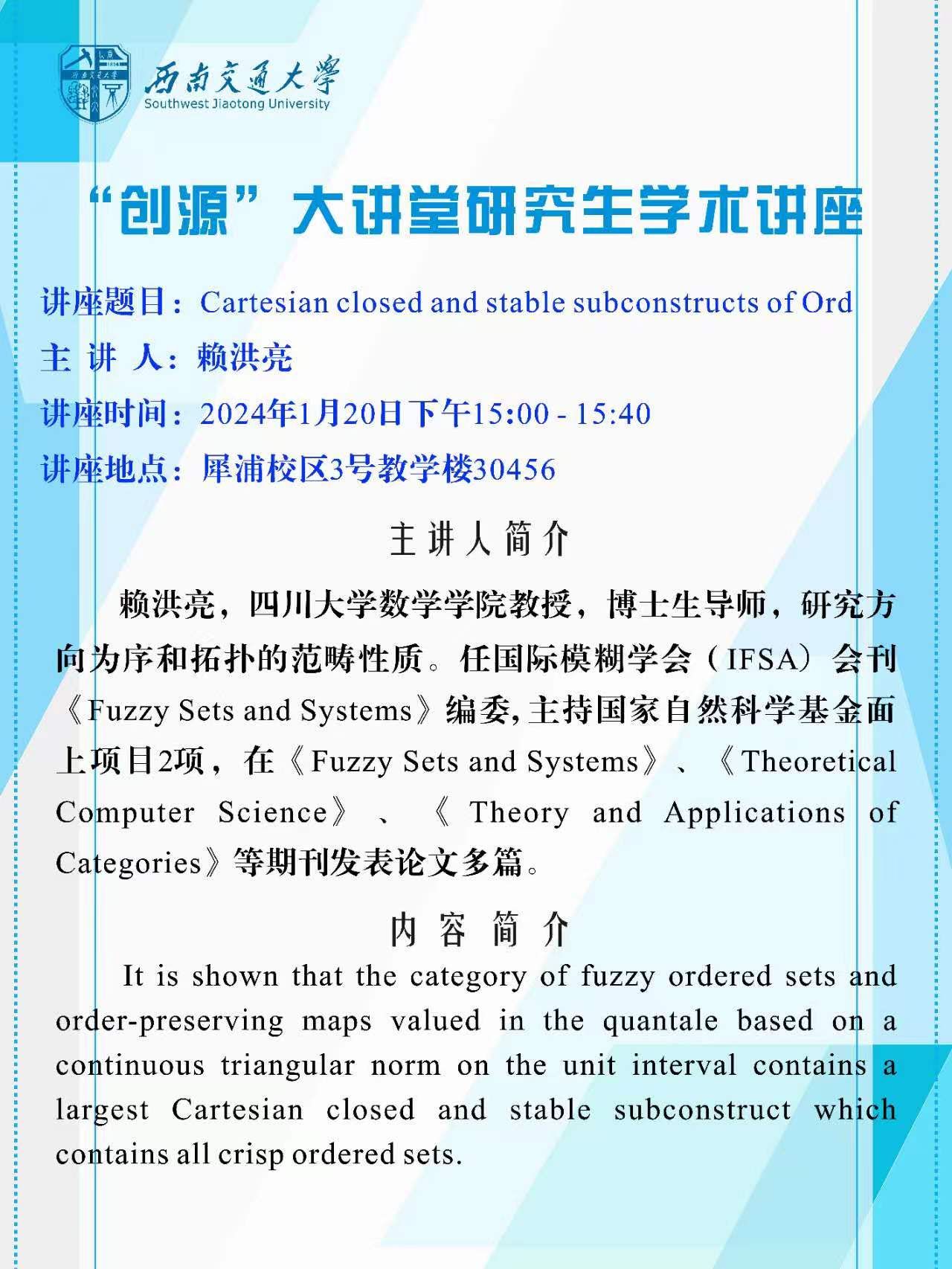 Cartesian closed and stable subconstructs of Ord数学学院内容简介
Cartesian closed and stable subconstructs of Ord数学学院内容简介 -
 创源大讲堂|Topic: A Concise Guide to Optimization vs. Simulation in Decision Making交通运输与物流学院2024年1月16日(周二)下午15:30犀浦校区交通运输与物流学院417学术报告厅余浩 挪威特罗姆瑟北极大学工业工程副教授兼项目负责人 Hao Yu is Associate Professor and Program Leader of Industrial Engineering (MSc) at UiT The Arctic University of Norway. His research interests are real-problem-driven model development to solve complex decision-making problems in sustainable supply chains, reverse logistics, location and network design, service systems, scheduling, and smart manufacturing and logistics in Industry 4.0/5.0. These optimization/simulation models can be used to minimize carbon footprints and environmental risks of logistics systems, improve the accessibility and cost efficiency of service networks, locate the charging stations for electric/hydrogen vehicles, autonomously configure reconfigurable manufacturing systems, improve the lockage efficiency of a water conservancy project, and so forth. He has led or been a key member of 10+ international projects funded by the Research Council of Norway, the Directorate of Higher Education and Skills, Innovation Norway, Nordplus, and EU and EEA Programmes. He has authored and co-authored 50+ scientific papers with 1500+ citations and 18 H-Index. Currently, his research focuses on the combination of predictive analytics, prescriptive analytics, and descriptive analytics in an Industry 5.0-enabled Smart Digital Logistics Twin that can be used in, for example, reverse logistics, humanitarian/epidemic logistics, and smart manufacturing/remanufacturing systems.内容简介Introduction: Optimization and simulation are the most important analytical techniques, and this talk will provide a concise guide to optimization vs. simulation in decision-making. Specifically, we will start with an urban postal service redesign problem in Norway. Due to recent technological advancements, more diversified customer demand, and increasingly harder competition, a strategic reform of urban postal service systems was undertaken in Norway in 2013, called post-in-shop. Decisions need to be made to replace traditional post offices with small-sized postal service counters in retail stores to improve accessibility, operational efficiency, and cost-effectiveness. To solve this problem, a two-stage method is proposed. First, two location models are employed to determine the optimal facility locations, and a simulation model is then built to evaluate the urban postal service system with different location and demand allocation plans under a realistic and stochastic environment. This case study will show both the strengths and the weaknesses of optimization and simulation and how they can be complementarily applied in decision-making. Furthermore, some other application scenarios using combined simulation and optimization methods, e.g., waste management, vaccine distribution, and smart manufacturing, will be briefly introduced.
创源大讲堂|Topic: A Concise Guide to Optimization vs. Simulation in Decision Making交通运输与物流学院2024年1月16日(周二)下午15:30犀浦校区交通运输与物流学院417学术报告厅余浩 挪威特罗姆瑟北极大学工业工程副教授兼项目负责人 Hao Yu is Associate Professor and Program Leader of Industrial Engineering (MSc) at UiT The Arctic University of Norway. His research interests are real-problem-driven model development to solve complex decision-making problems in sustainable supply chains, reverse logistics, location and network design, service systems, scheduling, and smart manufacturing and logistics in Industry 4.0/5.0. These optimization/simulation models can be used to minimize carbon footprints and environmental risks of logistics systems, improve the accessibility and cost efficiency of service networks, locate the charging stations for electric/hydrogen vehicles, autonomously configure reconfigurable manufacturing systems, improve the lockage efficiency of a water conservancy project, and so forth. He has led or been a key member of 10+ international projects funded by the Research Council of Norway, the Directorate of Higher Education and Skills, Innovation Norway, Nordplus, and EU and EEA Programmes. He has authored and co-authored 50+ scientific papers with 1500+ citations and 18 H-Index. Currently, his research focuses on the combination of predictive analytics, prescriptive analytics, and descriptive analytics in an Industry 5.0-enabled Smart Digital Logistics Twin that can be used in, for example, reverse logistics, humanitarian/epidemic logistics, and smart manufacturing/remanufacturing systems.内容简介Introduction: Optimization and simulation are the most important analytical techniques, and this talk will provide a concise guide to optimization vs. simulation in decision-making. Specifically, we will start with an urban postal service redesign problem in Norway. Due to recent technological advancements, more diversified customer demand, and increasingly harder competition, a strategic reform of urban postal service systems was undertaken in Norway in 2013, called post-in-shop. Decisions need to be made to replace traditional post offices with small-sized postal service counters in retail stores to improve accessibility, operational efficiency, and cost-effectiveness. To solve this problem, a two-stage method is proposed. First, two location models are employed to determine the optimal facility locations, and a simulation model is then built to evaluate the urban postal service system with different location and demand allocation plans under a realistic and stochastic environment. This case study will show both the strengths and the weaknesses of optimization and simulation and how they can be complementarily applied in decision-making. Furthermore, some other application scenarios using combined simulation and optimization methods, e.g., waste management, vaccine distribution, and smart manufacturing, will be briefly introduced. -
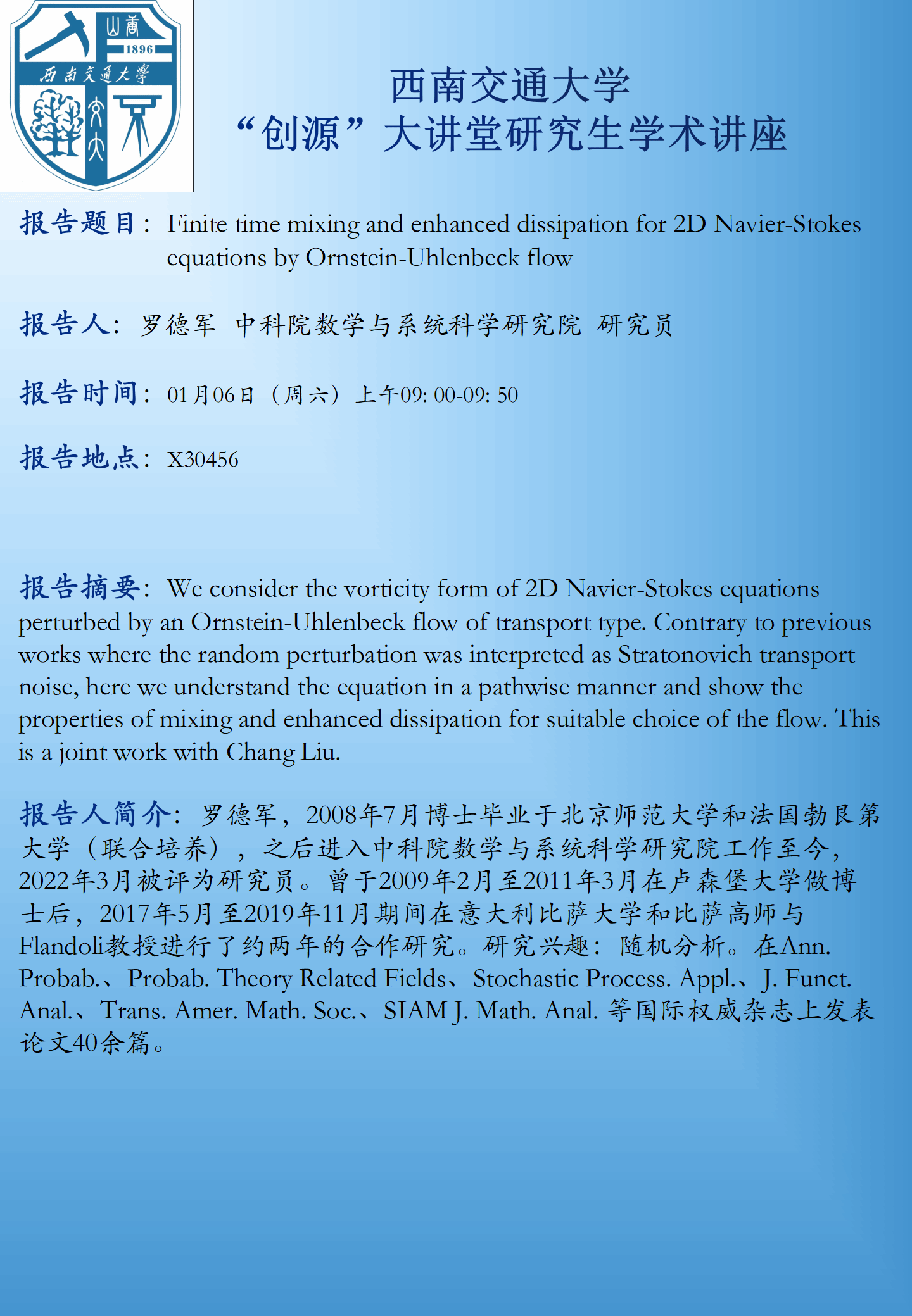 【“创源”大讲堂研究生学术讲座】Finite time mixing and enhanced dissipation for 2D Navier-Stokes equations by Ornstein-Uhlenbeck flow数学学院2024.01.06X30456罗德军 研究员内容简介
【“创源”大讲堂研究生学术讲座】Finite time mixing and enhanced dissipation for 2D Navier-Stokes equations by Ornstein-Uhlenbeck flow数学学院2024.01.06X30456罗德军 研究员内容简介 -
 【“创源”大讲堂研究生学术讲座】L^2-Exponential ergodicity for stochastic Hamiltonian systems with stable Levy noises数学学院2024.01.06X30456鲍建海 教授内容简介
【“创源”大讲堂研究生学术讲座】L^2-Exponential ergodicity for stochastic Hamiltonian systems with stable Levy noises数学学院2024.01.06X30456鲍建海 教授内容简介 -
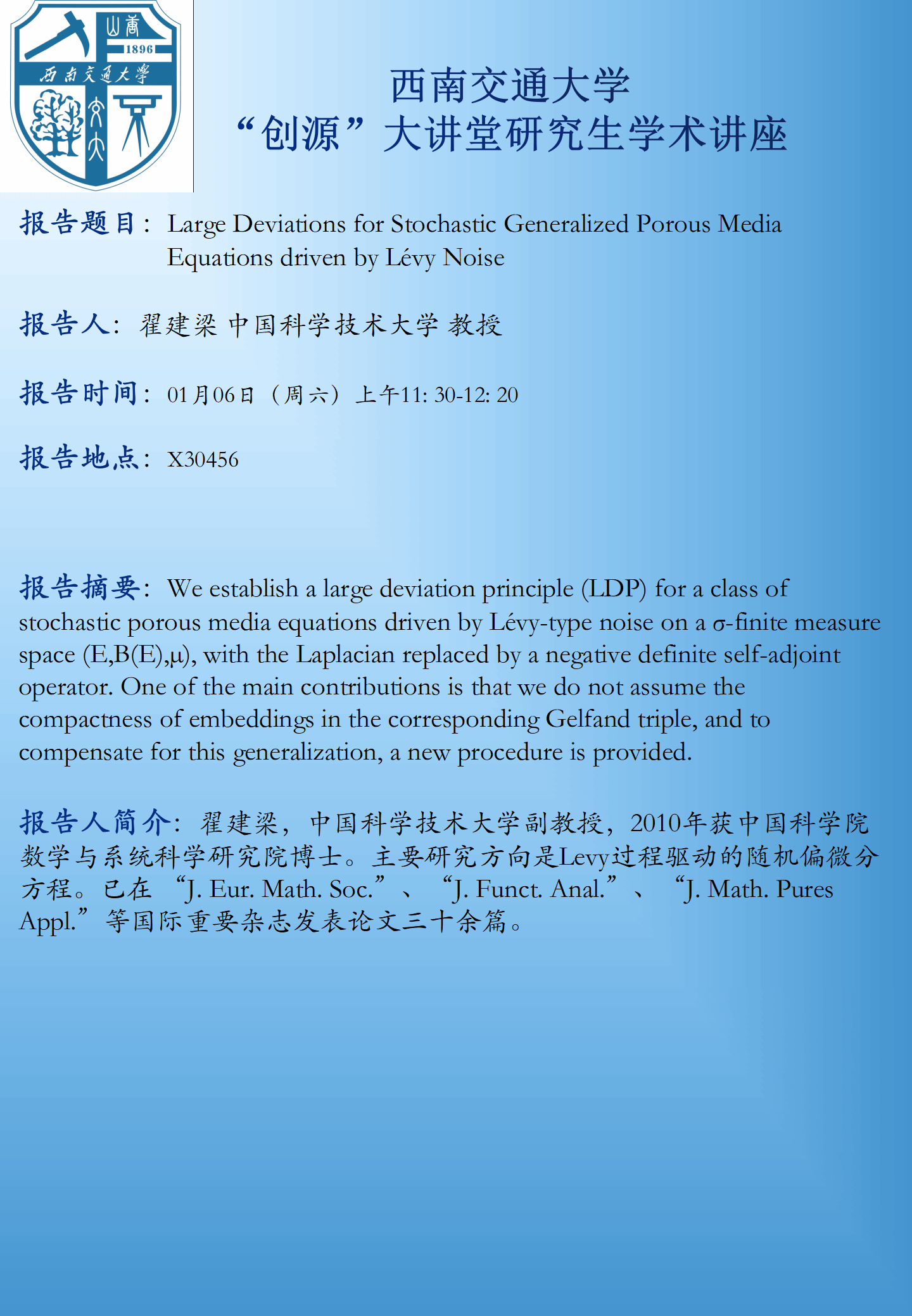 【“创源”大讲堂研究生学术讲座】Large Deviations for Stochastic Generalized Porous Media Equations driven by Lévy Noise数学学院2024. 01. 06X30456翟建梁 教授内容简介
【“创源”大讲堂研究生学术讲座】Large Deviations for Stochastic Generalized Porous Media Equations driven by Lévy Noise数学学院2024. 01. 06X30456翟建梁 教授内容简介 -
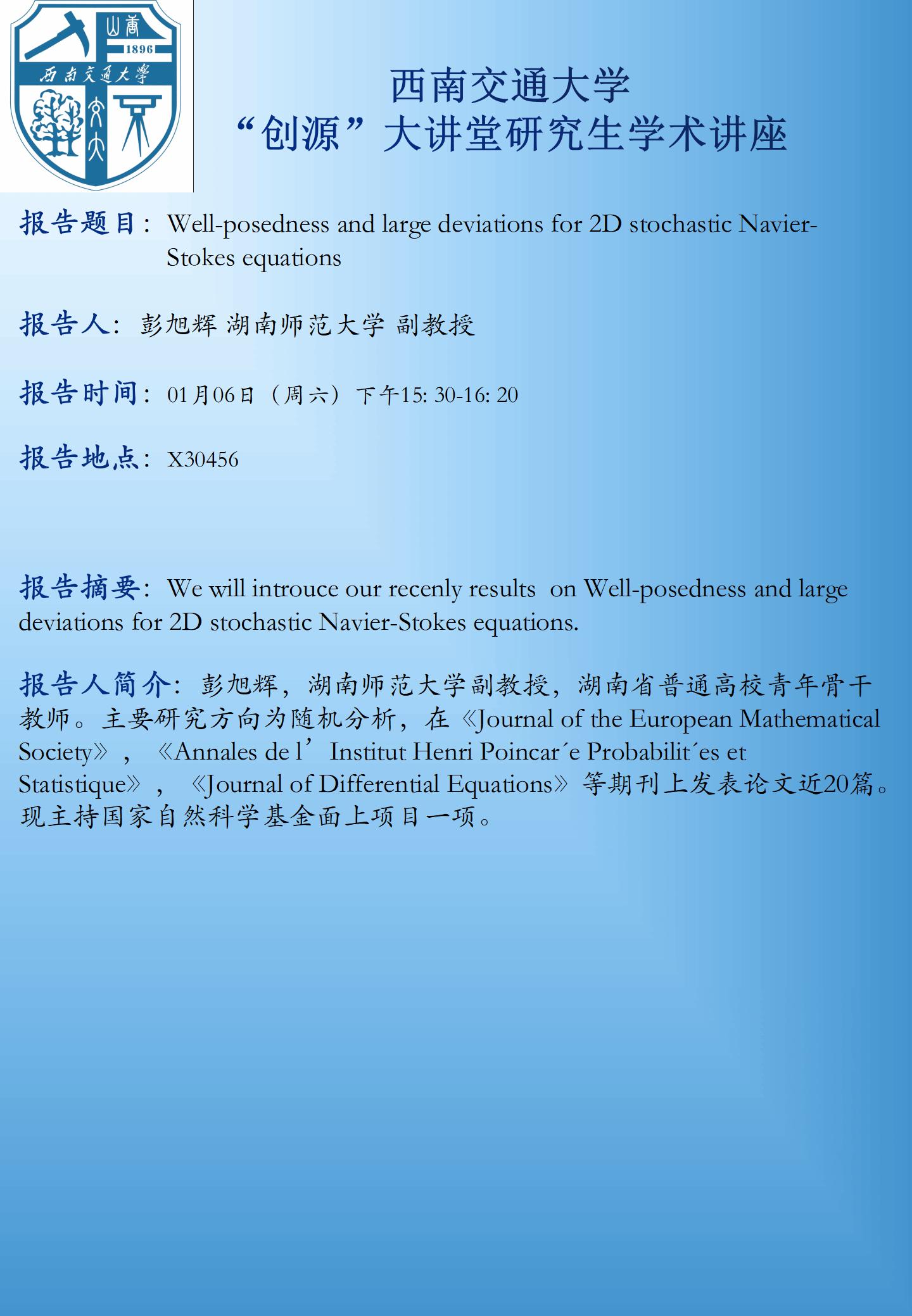 【“创源”大讲堂研究生学术讲座】Well-posedness and large deviations for 2D stochastic Navier-Stokes equations数学学院2024.01.06X30456彭旭辉 副教授内容简介
【“创源”大讲堂研究生学术讲座】Well-posedness and large deviations for 2D stochastic Navier-Stokes equations数学学院2024.01.06X30456彭旭辉 副教授内容简介









